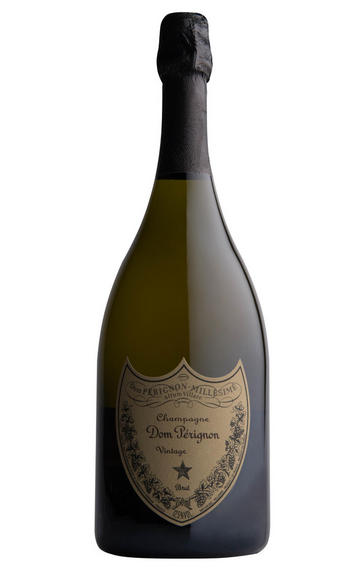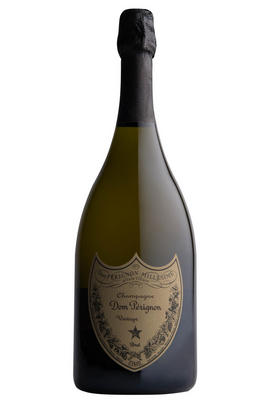
2008 Champagne Dom Pérignon, Brut

Critics reviews
A wine hyped by so many (me included) and tasted more than a dozen times over the last two years. Richard Geoffroy (ex-chef-de-cave) has performed a masterstroke, delivering that seemingly impossible combination of production volume and quality.
Using his experience of the similar 1996 vintage, Geoffroy patiently waited before picking (the entire harvest took almost a month!) to ensure the wines had better balance and phenolic ripeness.
One of the best young Dom Perignons I have tasted, a perfect blend of Chardonnay and Pinot Noir (neither grape dominating), the “struck-match”, reductive character doesn’t dominate as much as some vintage.
Sublime, cool fruited on the palate, compact with hidden density and a creamy finish that goes on and on. This will be a Dom Perignon for your children, but if you’re a selfish parent like I am, there will likely be none left to inherit!
Jasper Morris MW, InsideBurgundy.com (May 2020)
The 2008 Dom Pérignon is a huge, powerful Champagne and also clearly one of the wines of the vintage. This is one of the most reticent bottles I have tasted, so much so that I am considering holding off opening any more bottles!
The 2008 has always offered a striking interplay of fruit and structure. Today, the richness of the fruit is especially evident. Readers who own the 2008 should be thrilled, but patience is a must.
Drink 2028 - 2058
Antonio Galloni, Vinous.com (August 2021)
Drink 2021 to 2034
Jane Anson, Inside Bordeaux (December 2021)
Unquestionably the finest Dom Pérignon of the decade, the 2008 Dom Pérignon is drinking brilliantly today, wafting from the glass with notes of citrus oil, ripe orchard fruit, peach, buttered toast, pastry cream, iodine and smoky reduction.
Full-bodied, rich and fleshy, it's vinous and layered, with a deep core of sweet fruit, racy acids and a long, saline finish. The 2008 is ageing very gracefully.
Drink 2020 - 2040
William Kelley, Wine Advocate (August 2022)
Tasted blind. Very fresh and lively and creamy, lovely undertow. Long and tense. Really refreshing.
Drink 2019 - 2030
Jancis Robinson MW, JancisRobinson.com (April 2019)
Deep and generous, yet driven, with delicious salted butter and salted caramel notes underneath the initial lemon and chalk. Really expands on the palate in all directions. Lemon cream and shortcrust. Creamy yet underpinned by a sharp backbone of acidity throughout.
Drink or hold
James Suckling, JamesSuckling.com (July 2022)
The 2008 Dom Pérignon Rosé is impossibly youthful. Pinot Noir, notably from Hautvillers (lieu-dit Chants de Linottes) and Aÿ (Vauzelles), bring vibrant red berry and pomegranate fruit overlaid with hints of smoke and spice from the 12 years the wine spent on the lees.
The wine makes a powerful impact on the palate, with its grand, wonderful mousse and lively fresh acidity balancing out the wine-like vinous texture and depth of flavour. The ’08 DP Rosé has impressive power yet never loses sight of its elegance and delicacy; it should start to open in a few years and will continue to improve for another 50 years.
Drink 2030 - 2075
Charles Curtis MW, Decanter.com (January 2023)
About this WINE

Dom Perignon
Dom Pérignon was the 17th century Benedictine monk who has gone down in history as the person who "invented" Champagne. His name was originally registered by Eugène Mercier. He sold the brand name to Moët & Chandon, which used it as the name for its prestige cuvée, which was first released in 1937.
A rigorous selection process in both the vineyard and winery ensures that only the best grapes go into Dom Pérignon champagne. Chardonnay and Pinot Noir are used in roughly equal proportions without one variety dominating the other.
In its youth, Dom Pérignon shows incredibly smooth, creamy fruit with perfect balance and weight. As it ages, it takes on wonderfully toasty aromas and a finesse equalled by very few of the other Grandes Marques.
Since 2014 Dom Pérignon has no longer been using the term oenothèque for its late-release Champagnes, but the word Plenitude. This style represents Dom Pérignon champagne that is left in contact with its lees and does not evolve in a linear fashion, but ages in a series of stages, producing “windows of opportunity, or plenitudes” when the Champagne can be disgorged and released to bring consumers a different expression of the same vintage.
There are three plenitudes in the life of a given vintage: the first plenitude spans between seven to eight years after the vintage, which is when Dom Pérignon Vintage is released, while the second one arrives between 12 and 15 years – which was previously the first oenothèque release, but from now will be branded as P2. The third window comes after around 30 years, when the Champagne has spent more than 20 years on its lees, which will now be termed as P3.

Brut Champagne
Brut denotes a dry style of Champagne (less than 15 grams per litre). Most Champagne is non-vintage, produced from a blend from different years. The non-vintage blend is always based predominately on wines made from the current harvest, enriched with aged wines (their proportion and age varies by brand) from earlier harvests, which impart an additional level of complexity to the end wine. Champagnes from a single vintage are labelled with the year reference and with the description Millésimé.
Non-vintage Champagnes can improve with short-term ageing (typically two to three years), while vintages can develop over much longer periods (five to 30 years). The most exquisite and often top-priced expression of a house’s style is referred to as Prestige Cuvée. Famous examples include Louis Roederer's Cristal, Moët & Chandon's Dom Pérignon, and Pol Roger's Cuvée Sir Winston Churchill.
Recommended Producers : Krug, Billecart Salmon, Pol Roger, Bollinger, Salon, Gosset, Pierre Péters, Ruinart

Champagne blend
Which grapes are included in the blend, and their proportion, is one of the key factors determining the style of most Champagnes. Three grapes are used - Pinot Noir, Chardonnay and Pinot Meunier.
26% of vineyards in Champagne are planted with Chardonnay and it performs best on the Côtes des Blancs and on the chalk slopes south of Epernay. It is relatively simple to grow, although it buds early and thus is susceptible to spring frosts. It produces lighter, fresher wines than those from Burgundy and gives finesse, fruit and elegance to the final blend. It is the sole grape in Blancs de Blancs, which are some of the richest long-lived Champagnes produced.
Pinot Noir accounts for nearly 40% of the plantings in Champagne and lies at the heart of most blends - it gives Champagne its body, structure, strength and grip. It is planted across Champagne and particularly so in the southern Aube district.
The final component is Pinot Meunier and this constitutes nearly 35% of the plantings. Its durability and resistance to spring frosts make the Marne Valley, a notorious frost pocket, its natural home. It ripens well in poor years and produces a soft, fruity style of wine that is ideal for blending with the more assertive flavours of Pinot Noir. Producers allege that Pinot Meunier lacks ageing potential, but this does not deter Krug from including around 15% of it in their final blends.


Buying options
Add to wishlist
Description
A wine hyped by so many (me included) and tasted more than a dozen times over the last two years. Richard Geoffroy (ex-chef-de-cave) has performed a masterstroke, delivering that seemingly impossible combination of production volume and quality.
Using his experience of the similar 1996 vintage, Geoffroy patiently waited before picking (the entire harvest took almost a month!) to ensure the wines had better balance and phenolic ripeness.
One of the best young Dom Perignons I have tasted, a perfect blend of Chardonnay and Pinot Noir (neither grape dominating), the “struck-match”, reductive character doesn’t dominate as much as some vintage.
Sublime, cool fruited on the palate, compact with hidden density and a creamy finish that goes on and on. This will be a Dom Perignon for your children, but if you’re a selfish parent like I am, there will likely be none left to inherit!
Jasper Morris MW, InsideBurgundy.com (May 2020)
wine at a glance
Delivery and quality guarantee